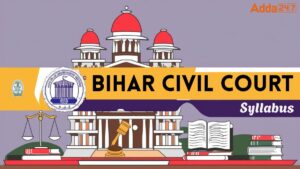Table of Contents
NABARD Grade A Syllabus 2023
NABARD Grade A Syllabus 2023: The NABARD Grade A notification is expected to be released soon. The syllabus and exam pattern for the NABARD Grade A exam are important for the candidates to understand so that they can prepare accordingly. The syllabus for the NABARD Grade A exam is divided into two parts: prelims and mains. By understanding the NABARD Grade A Syllabus, the candidates can create a study plan and focus on the most important topics. Read the article below to get detailed and updated NABARD Grade A Syllabus 2023.
NABARD Grade A Syllabus 2023: Overview
Understanding the essential components of the NABARD Grade A test is essential as the NABARD Grade A 2023 announcement is about to be released. The key points of the NABARD Grade A Syllabus 2023 are listed below. Here is a summary of the NABARD Grade A Syllabus for 2023 for all applicants.
| NABARD Grade A Syllabus 2023 | |
| Organization | Nation Bank for Agriculture and Rural Development Grade A |
| Exam Name | NABARD Grade A 2023 |
| Category | Syllabus |
| Exam Syllabus/Pattern | Prelims, Mains, Interview |
| Maximum Marks | Prelims – 200 Marks, Mains – (Paper 1) 100 Marks + (Paper 2) 100 Marks, Interview 50 Marks |
| Time Duration | Prelims – 2 Hr, Mains Paper 1 – 1.5 Hr, Mains Paper 2 – 2 Hr |
| Application mode | Online |
| Post name | Assistant Manager |
| Application Start Date | (Expected to be released soon) |
| Official website | www.nabard.org |
NABARD Grade A Exam Pattern
The NABARD Grade A exam follows a three-stage selection process, which includes Prelims, Mains, and the Interview round.
NABARD Grade A Exam Pattern (Prelims)
The Prelims exam is the first stage of the selection process, and it is considered to be of qualifying nature. This means that the marks obtained in the Prelims will not be taken into account for the final selection. Its purpose is to shortlist candidates for the next stage of the recruitment process, which is the main examination.
The Prelims exam consists of 200 multiple-choice questions. For each incorrect answer, 25% of the marks allotted to the question will be deducted as negative marks. Candidates are given a duration of two hours to complete this examination.
| Sections | Marks | Time Allotted |
| English Language | 40 | Total Time of 2 Hr |
| Reasoning Ability | 20 | |
| Quantitative Ability | 20 | |
| General Awareness | 20 | |
| Computer | 20 | |
| Economic and social affairs | 40 | |
| Agriculture and rural development | 40 | |
| Total | 200 |
NABARD Grade A Exam Pattern (Mains)
Candidates who have successfully cleared the Prelims exam are eligible to appear for the Mains exam. Generally, around four times the total number of vacancies are selected for the Mains exam based on the cut-off scores from the Prelims. The Mains exam consists of two papers. Details of the papers are given below. In Paper 2 (objective type), for each wrong answer, 25% or 1/4 marks will be deducted as negative marking.
Paper 1 – General English (Descriptive Paper): This paper is common for all candidates. It is a descriptive paper where candidates are required to write essays, comprehension passages, precis writing, and report/letter writing.
Paper 2 – General Post-Economic and Social Issues and Agriculture and Rural Development: Paper 2 is both descriptive & objective type paper. It covers topics related to General Post-Economic and Social Issues and Agriculture and Rural Development.
| Paper | Type | Section | Marks | Time Allotted |
| Paper 1 | Descriptive | General English | 100 | 1.5 Hr |
| Paper 2 | Objective | Economic and Social Issues, Agriculture,
Rural Development. |
50 | 0.5 Hr |
| Paper 2 | Descriptive | 50 | 1.5 Hr | |
| Total | 200 | 3.5 Hr | ||
Candidates who perform well in the NABARD Grade A Mains examination will be shortlisted for the final stage of the selection process, which is the Interview round. The interview round evaluates the candidate’s personality, communication skills, subject knowledge, and suitability for the role of Assistant Manager in NABARD.
Prelims NABARD Grade A Syllabus 2023
The Syllabus for NABARD Grade A Syllabus 2023 for Prelims. Interested Candidates keep reading the Details below.
| Name of Section | Topics |
|
Reasoning Ability |
|
| Quantitative Aptitude |
|
| English Language |
|
| General Awareness |
|
| Computer Knowledge |
|
NABARD Grade A Mains Syllabus 2023
The Syllabus for NABARD Grade A Syllabus 2023 for Mains. Interested Candidates keep reading the Details below.
Economic & Social Issues
| Topic Name | NABARD Grade A Syllabus |
| Nature of Indian Economy | Structural and Institutional features, Economic Underdevelopment, Opening up the Indian Economy, Globalization, Economic Reforms in India, Privatization. |
| Inflation | Trends in Inflation & their Impact on National Economy and Individual Income. |
| Poverty Alleviation and Employment Generation in India | Rural and Urban, Measurement of Poverty, Poverty Alleviation Programmes of the Government. |
| Population Trends | Population Growth and Economic Development, Population Policy in India. |
| Agriculture | Characteristics / Status, Technical and Institutional changes in Indian , Agriculture, Agricultural performance, Issues in Food Security in India, Non-Institutional and Institutional Agencies in rural credit. |
| Industry | Industrial and Labour Policy, Industrial performance, Regional Imbalance in India’s Industrial Development, Public Sector Enterprises. |
| Rural banking and financial institutions in India | Reforms in the Banking/ Financial sector. |
| Globalization of Economy | Role of International Funding Institutions, IMF & World Bank, WTO , Regional Economic Co-operation. |
| Social Structure in India | Multiculturalism, Demographic trends, Urbanization and Migration, Gender, Issues Joint family system, Social Infrastructure, Education, Health and Environment. |
| Education | Status & System of Education, Socio-Economic Problems associated with Illiteracy, Educational relevance and educational wastage, Educational Policy for India. |
| Social Justice | Problems of scheduled castes and scheduled tribes, Socio-economic programs for scheduled castes and scheduled tribes and other backward classes. |
| Positive Discrimination in favor of the underprivileged | Social Movements, Indian Political Systems, Human Development |
Agriculture & Rural Development
| Topic Name | Details |
| Agriculture |
|
| Soil and Water Conservation |
|
| Water Resource |
|
| Farm and Agri Engineering |
|
| Plantation & Horticulture |
|
| Animal Husbandry |
|
| Fisheries |
|
| Forestry |
|
| Agriculture Extensions |
|
| Ecology and Climate Change |
|
| Present Scenario of Indian Agriculture and Allied activities |
|
Rural Development
| Topic | Details |
| Rural Development |
|
NABARD Grade A Syllabus 2023, Prelims and Mains Exam Pattern, Read in Hindi




 RRB ALP Syllabus 2025, Check detailed Sy...
RRB ALP Syllabus 2025, Check detailed Sy...
 Bihar Civil Court Syllabus 2025 Check De...
Bihar Civil Court Syllabus 2025 Check De...
 BSSC Inter Level Syllabus and Exam Patte...
BSSC Inter Level Syllabus and Exam Patte...


